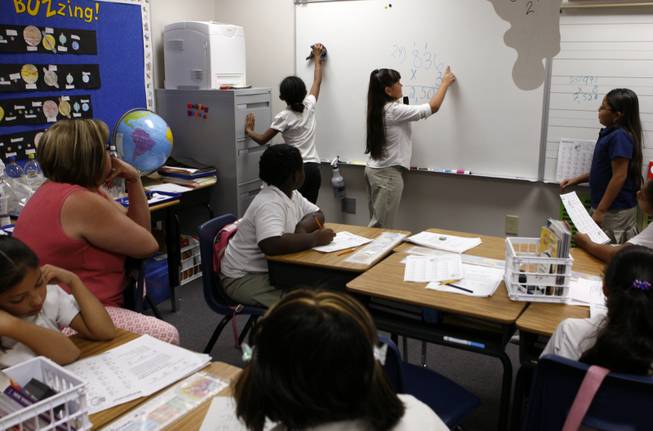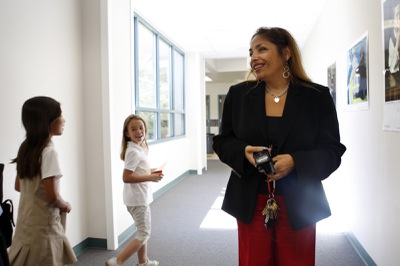
Soraya Gonzalez-Tarin, center, work on a math problem this month in her class at Diaz Elementary. Last year Diaz and its sister campus, Cortez Elementary, were the first in the Clark County School District to go with single-sex classrooms in all grades.
Sunday, July 19, 2009 | 2 a.m.
Sun Archives
In the boys-only fifth grade classroom at Diaz Elementary School, students are free move about. As they work independently on a writing assignment, some sprawl on the floor, others lean against the wall. The teacher speaks loudly to be heard above the hum of activity and classical music playing in the background.
Down the hall, in the girls-only first grade class, it appears another species, not gender, might be at work here.
The girls sit at desks in tidy rows, face to face as they collaborate on a writing project. The only sound is their quiet chatter as they discuss their work.
These single-sex classrooms are part of a Clark County School District experiment to see whether teaching boys and girls separately improves academic performance. The jury is still out, but not for a small group of local educators who are convinced that boys and girls learn so differently that teaching them the same way, in the same room, shortchanges the group.
•••
The district has since 2002 used single-sex classrooms for certain subjects and grades. For the 2008-09 academic year 14 campuses offered such classes to try to close achievement gaps between boys and girls in math, reading and science.
(The gap is more pronounced in the lower grades, where girls typically score higher than boys on standardized tests. It narrows in the upper grades — boys outscored girls on the math section of the high school proficiency exam — but girls have a higher graduation rate.)
Diaz, which opened in 2008, and its sister campus, Cortez Elementary, became the first schools to adopt single-sex education campuswide this past school year.
Diaz Principal Maribel McAdory said everything from the color of classroom walls — boys had blue, girls yellow — to the volume of the teacher’s voice was a research-based decision intended to foster educational progress.
“You can’t just split the genders up,” McAdory said. “You need to know why you’re doing it. You need to understand the strategies.”
David Amour, who teaches fifth grade boys at Diaz, said his first year teaching a boys-only class was a learning experience.
There were some surprises. For the first time, the boys raised their hands and volunteered to read poetry aloud. They made their way enthusiastically through a scaled-down version of Shakespeare’s “Romeo and Juliet.” And there were almost no behavioral problems.
Amour also made some adjustments. Research shows that boys don’t hear as well as girls do, Amour said, so he spoke in a louder voice. He occasionally played classical music in the background to provide extra stimulation that the boys enjoyed while working on their own.
“They’re always doing something,” Amour said of his class of boys. “But if you let them stand up and move around, they pay better attention.”
Based on his experience and research, the 16-year teacher will make some adjustments when students return next month.
He has read that boys who have trouble concentrating do better if they have something to occupy their hands as they work. He will be distributing stress balls for the students to squeeze and will affix strips of Velcro beneath their desks, which they can run their fingers over during class.
Amanda Soltis taught two years of co-ed kindergarten before being assigned last year to a girls-only first grade class at Diaz.
Training she received before the start of school prepared her for leading a single-sex classroom, she said. But it didn’t prepare her for how quiet her class would be, Soltis said with a laugh.
“After a while, I could just step back and know they would be doing what they were supposed to be doing,” she said.
Students also found the experience wasn’t what they had anticipated.
Fourth grader Arianna Stacey said when she learned her class would be all girls, she “worried there would be a lot of drama.” But without the boys in the room, the girls seem to be friendlier, Arianna said.
Soltis will return to a co-ed classroom in August. But she said she will bring to the class a greater understanding of differences between boys’ and girls’ learning styles.
The girls she taught this year sought her approval for nearly everything they did, no matter how small the task. One thing she said she will emphasize is helping the girls build more confidence in their abilities, independent of her reaction.
•••
Researchers aren’t settled on the effectiveness and long-term effects of single-sex education.
Those in favor say it removes the inherent distractions that come with mixing boys and girls. Gender-specific classes also encourage students to expand their academic horizons — girls are more likely to pursue careers in mathematics and science while boys show increased participation in language and arts programs, they say.
Clark County educators base their instruction on the teachings of Dr. Leonard Sax, executive director of the National Association for Single Sex Public Education.
Sax, who has traveled to Las Vegas to visit district schools and consult with staff, espouses the theory that brain development in boys and girls is different enough that to thrive they need individually tailored educational environments. The author of two books on gender and academic achievement, he cites research showing girls are less confident in their academic abilities even though they get better grades than boys.
Boys “tend to have unrealistically high estimates of their own academic abilities and accomplishments,” Sax wrote recently. Therefore, girls need to be encouraged and have their self confidence boosted, and boys need “a reality check — to make them realize they are not as brilliant as they think they are, and challenge them to do better.”
Sax, who is a psychologist as well as a physician, said because boys and girls process information differently, one instructional approach for both is less likely to be effective.
For example, adding an element of competition to a math lesson is likely to work with boys, but typically has little effect on girls, he says.
When teachers provide real-world context for instruction, it can enhance the learning experience for girls, Sax says. The same lesson is likely to leave boys bored and distracted.
A general rule for boys, Sax writes: Avoid questions that begin with the phrase, “How would you feel if ...”
Critics of same-gender education say much of the research cited by Sax and others is outdated. Some say it reinforces harmful stereotypes about the abilities and limitations of boys and girls.
“When they start stereotyping that boys learn this way and girls learn that way, alarm bells should be going off for every educator who knows full well that every child learns differently,” said David Sadker, a professor emeritus at American University who has spent almost 40 years researching gender bias. “What do boys and girls think of each other if they’re told they can’t learn together? What do we lose when everyone in the classroom is the same color, gender and socioeconomic class? Of all the countries that should be doing this, our democracy should be last.”
Instead of separating boys and girls, public schools should focus on how to make co-ed classrooms work for all students, said Sadker, who devotes a chapter to single-sex education in a new book he co-wrote, “Still Failing at Fairness.”
The recent surge in single-sex classrooms — in 2002, just 11 public schools in the United States offered single-sex classes, this year there were more than 540 — followed an easing by the U.S. Education Department of the restrictions imposed by Title IX, the 1972 law banning gender discrimination in public schools.
The department mandates that participation in such classes be voluntary and districts must provide “substantially equal” learning opportunities for the students who are not segregated by gender.
(Because Diaz and Cortez serve the same Clark County attendance zone, the district agreed that the two schools’ “opt out” students can be combined. Cortez has one mixed-gender classroom each in grades one, two and four, and Diaz offers mixed classes in third and fifth grades.)
Allen Lichtenstein, attorney for the American Civil Liberties Union of Nevada, finds the School District’s foray into single-sex education troubling even if it complies with federal law.
“Let’s suppose that they decide that racially integrated classrooms are not a good idea and don’t help student achievement,” Lichtenstein said. “Would we then have separate classrooms for blacks and whites?”
In an interview with the Sun, Sax acknowledged that improperly executed single-sex education can reinforce gender stereotypes instead of breaking them down.
Teachers in an Alabama school district, which recently shut down a mandatory single-sex program following a challenge from the ACLU, were accused of encouraging girls to write about wedding dresses and boys to write about hunting.
“Schools would be better off sticking to co-ed than to try and go ahead without the training,” Sax said, adding that the fundamentals can be covered in a few days. For single-sex education to work, “you need to train your teachers and educate your parents.”
•••
At Cheyenne High School, which has for several years used single-sex education in ninth and 10th grades, Principal Jeff Geihs evaluated the students of teachers who had both co-ed and single-sex classes.
For the 2008-09 academic year, the pass rate for the boys-only geometry class was 72.3 percent, compared with 70 percent for boys in co-ed classes. The girls-only world history class had a markedly higher pass rate, 88 percent, than the co-ed class, 81 percent. But in other classes, such as boys-only world history and girls-only algebra, co-ed classes outperformed the single-sex classes.
Those statistics tell only part of the story, Geihs said. Other considerations, which he’s in the process of evaluating, include whether students made gains over previous academic performance and whether classroom behavior has improved.
Still, Geihs said he’s confident that, overall, the program is having a positive effect.
The first year of any educational initiative is typically considered the baseline for measuring student achievement. In addition to Diaz, seven Clark County campuses are completing their first year of single-sex schooling.
At Cortez, which began a limited use of single-sex classes in 2007 before expanding last fall, Principal Ariel Villalobos is declaring it a success. He said he’s seen significant improvement in the overall learning environment and a steep drop-off in discipline issues for boys and girls.
At Diaz, McAdory, the principal, said boys-only classes have made strong progress, particularly in literacy. Girls-only classes are also doing well, but the gains aren’t as pronounced. Part of the reason is that the girls were doing well as a group and had less ground to make up, McAdory said.
Martin Curiel’s son Eric is finishing third grade at Diaz, where he has been taught in a boys-only class. Curiel said he isn’t sure whether he agrees with the logic behind single-sex schooling, but he does know that Eric made significant progress in reading this year — something he struggled with last year.
“I don’t know if boys and girls really do learn differently — I know that’s the theory,” Curiel told the Sun as he dropped Eric off for class. “But whatever it is, it’s working.”



Join the Discussion:
Check this out for a full explanation of our conversion to the LiveFyre commenting system and instructions on how to sign up for an account.
Full comments policy